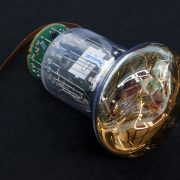2nd DOM integration workshop
27 May 2025 – Do you know how the optical modules of KM3NeT are built? This has been shown and practised in the second edition of the Digital Optical Module (DOM) integration workshop which took place last week.
27 May 2025 – Do you know how the optical modules of KM3NeT are built? This has been shown and practised in the second edition of the Digital Optical Module (DOM) integration workshop which took place last week.
 31 May 2018 – Each KM3NeT optical sensor module contains 31 photomultiplier tubes. Each KM3NeT detection unit comprises 18 optical modules, i.e. a total of 18 x 31 = 558 photomultipliers. Together the ARCA and ORCA detectors of KM3NeT will comprise a total of 345 detection units, i.e. 345 x 558 =192,510 photomultipliers. So, you can imagine that it is important to very well understand the characteristics of these photomultipliers. Read more
31 May 2018 – Each KM3NeT optical sensor module contains 31 photomultiplier tubes. Each KM3NeT detection unit comprises 18 optical modules, i.e. a total of 18 x 31 = 558 photomultipliers. Together the ARCA and ORCA detectors of KM3NeT will comprise a total of 345 detection units, i.e. 345 x 558 =192,510 photomultipliers. So, you can imagine that it is important to very well understand the characteristics of these photomultipliers. Read more